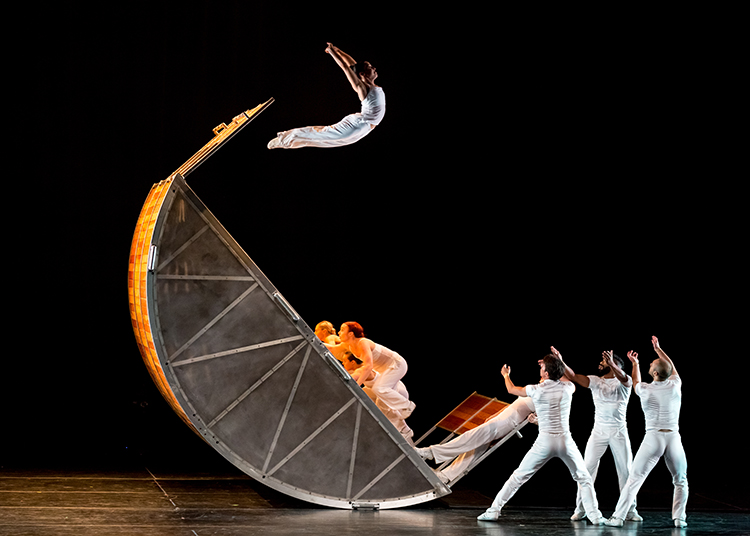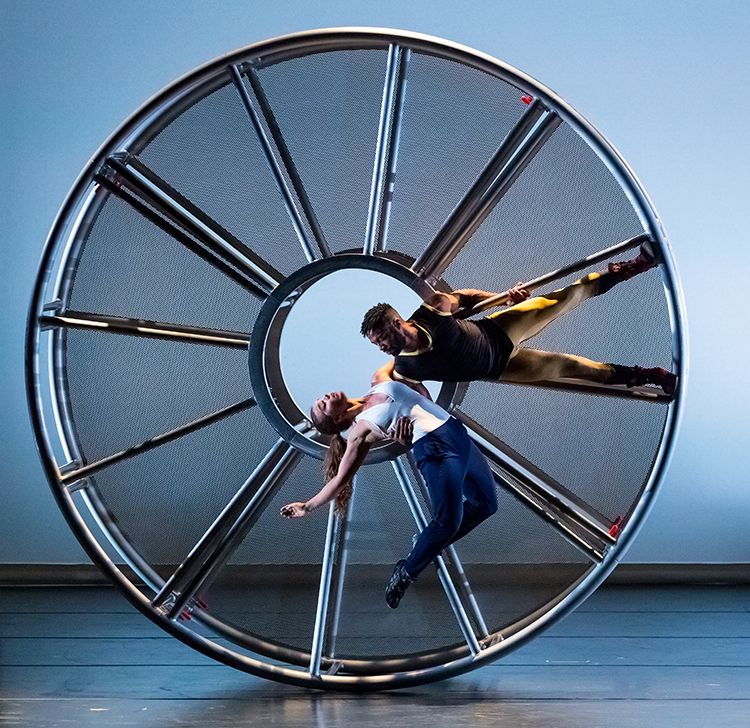Writer Joseph J. Airdo
Photography Courtesy of Sharen Bradford
[dropcap]M[/dropcap]any years ago, French-born dance choreographer Jacques Heim was living in an apartment complex in Hollywood. He did not know any of his neighbors until an earthquake shook the area.
“Suddenly, the neighbors started sharing food, blankets and water,” Heim recalls. “We finally started creating this beautiful community—living together and helping one another.”
Heim was moved by the experience and sought to instill the humanity that he felt as a result of it into Diavolo, the dance company that he founded in 1992.
“Sometimes, modern society does not allow us to actually help one another,” Heim explains. “We are so individual and so much in our own world and cocoon because life is complex. I wanted audiences to see the power and the beauty of humans helping one another, supporting one another, teaching one another—like it is their last day on Earth.”
That is one of the reasons there is an element of danger in the repertoire of Diavolo, which will perform at 8 p.m. Nov. 22 at Scottsdale Center for the Performing Arts. Exactly what the company will be performing, though, is somewhat difficult to describe—even for Heim.
The artistic director likens Diavolo’s identity to a salad in which he—a French chef in this scenario—mixes a fusion of different movements. Chef Heim begins by chopping up some everyday movement and placing it into a bowl. To that, he adds a little bit of ballet, a sliver of modern dance, a sprinkle of gymnastics, a fair amount of acrobatics and a morsel of martial arts.
“Then I will tweak it and toss it before adding an architectural environment—large structures that the dancers live in,” says Heim, noting that he is not a dancer and is, in fact, the most dyslexic and unflexible artistic director you will ever meet. “Those structures tell a story or transmit a feeling.
“I wish I could have been an architect but I did not have the discipline to be one. So I decided to mix my loves—the love of movement, the love to push human beings beyond their limits and the love for the language of architecture.”
Diavolo’s repertoire features a variety of different set pieces inspired by architecture, hence the company’s show title Architecture in Motion.
Set pieces include a 3,000-pound boat that symbolizes the transcendence of the human soul against all odds; several skateboard ramps that represent an urban environment with ever-shifting physical and emotional spaces; and a giant morphing staircase with multiple doors, passageways and shifting surfaces showing the tenuous balance we attempt to strike each day.
Diavolo’s newest adventure, inspired by travels in space and the first moon landing, sees gravity-defying bodies encountering whimsical, kinetic structures in a challenging environment. Heim gets the ideas for the company’s repertoire from the very world in which we live and breathe.
“I travel and walk a lot,” Heim says. “Sometimes I see something that catches my attention—something that is peculiar, something that I am curious about or something that I want to analyze.”
Heim uses a recent experience with a hotel’s large glass revolving door as an example to shine some light on his thought process. He recalls watching a woman, who had just arrived at the hotel with her suitcase, enter the revolving door.
“There were all of these other people coming from the inside of the hotel, and one of the suitcases got stuck,” Heim says. “The woman entering and a man exiting suddenly got stuck in the revolving door and were facing one another, trying to negotiate how they were going to move.”
Heim aspires to one day create and add to Diavolo’s repertoire a gigantic revolving door that represents the revolving door of our lives in which we sometimes get stuck.
“I can take that concept of the hotel and put it into a metaphor about life,” Heim explains.
Over the past 20 years, Diavolo has appeared before audiences in 250 cities and 14 countries and has performed to sold-out crowds throughout the U.S. Two years ago, Heim’s imaginative ideas and creative choreography propelled Diavolo to the finale of NBC’s reality competition series “America’s Got Talent,” introducing the company to audiences across the country.
However, Heim acknowledges that there is only so much that can be seen, experienced and felt through a television screen.
“Seeing Diavolo live is exciting because you do not really understand what you seeing,” Heim says. “It is very visceral. It transports you to a place that makes you use a bit of imagination. It is like a journey that you take.”
Heim notes that it is not uncommon for audiences to stand up and cheer at the end of Diavolo’s performances—not because the shows are a spectacle but because the performers have exemplified excellent teamwork.
“You see these men and women on stage working together as a unit, as a community, as a family.” Heim says. “There is a little bit of envy because you wish that you could be part of it.
“You recognize that these performers on stage are fighting together like great gladiators to make this extraordinary journey happen. They work together as a battalion of men and women in the trenches of war. You see this team facing an adversary because this work is dangerous.”
Heim reiterates that Diavolo is like no other dance company. He therefore looks for the perfect performers to bring his ideas and choreography to life. Diavolo’s dancers should have some technique—especially ballet, since the artistic director believes that is the basis of all movement. But instead of talent, Heim looks for dancers’ commitment to themselves.
“I look for individualism,” he explains. “I look for artists who have something to say and something to fight for. They do not have to be the best dancer ever, but they have to have passion and they have to move like they are taking their last breath.”
Heim aspires to create more than just art with Diavolo. He aims to push his performers beyond their physical, mental and emotional limits so that they can discover their full potential.
“They can then discover who they are and eventually be able to accomplish anything that they put their minds to,” Heim says. “Diavolo is more than a dance company. It is a program.”
That mindset is what fuels Heim’s mission for the company, which has incorporated educational and community outreach since its inception. Through The Diavolo Institute, the company shares the power of dance as a means of social impact with people of all ages and abilities.
In 2016, The Diavolo Institute expanded upon the programs it offers.
“Three years ago, we started to work with the veteran community,” Heim says. “We offer movement workshops for the men and women of the armed forces who have PTSD. The movement of Diavolo becomes medicine to those veterans. Our movement workshop is basically a restoration of their mental, emotional and physical strength.”
Heim adds that working with the veteran community has forever changed his life and that of the company.
“When you can use your art to serve and help others, you realize your greater mission in life,” Heim explains.
“Twenty-seven years ago, I had no idea what I was doing. Three years ago, I finally connected the dots. The reason I have a dance company in the United States of America is to help and to celebrate humans.”
Diavolo: Architecture in Motion
Friday, Nov. 22 | 8 p.m. | Scottsdale Center for the Performing Arts | 7380 E. Second St., Scottsdale | $29+ | diavolo.org








Comments by Admin